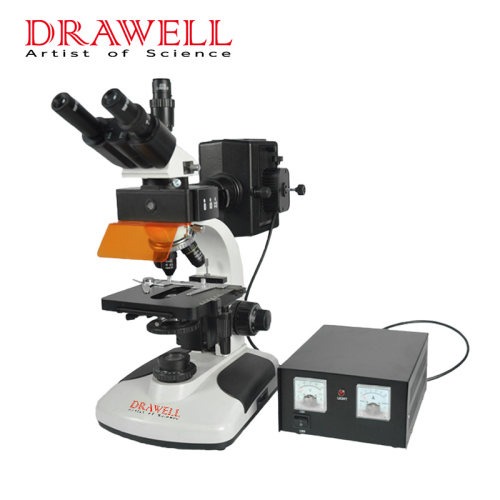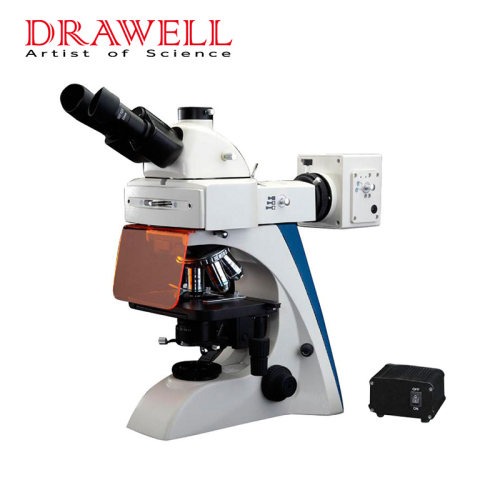This article will introduce you to how to choose a light source for a fluorescence microscope from fluorescence, factors affecting the effect of a fluorescence microscope, and light sources for a fluorescence microscope.
What is Fluorescence?
A fluorescence microscope is an instrument developed by using the principle of fluorescence phenomenon, which is widely used in biotechnology, medical treatment, mineral exploration, and other fields. Fluorescence is a cold luminescence phenomenon of photoluminescence. When a certain substance is irradiated by incident light of a certain wavelength, the substance absorbs light energy and enters an excited state, and immediately de-excites to release energy in the form of light.
The light emitted from a certain substance after excitation is fluorescence, usually, the wavelength of the outgoing light is longer than the wavelength of the incoming light. Once the incident light is stopped for most fluorescent substances, the luminescent phenomenon will also disappear. This phenomenon is widely used in biochemical medicine, lighting, and mineral exploration.
Factors Affecting Imaging Effect of Fluorescence Microscope
In recent years, a variety of new fluorescent dyes and various specialized fluorescent probes have emerged. There are hundreds of fluorescent dyes, fluorescent probes, fluorescent proteins, and other materials on the market. How to configure a suitable fluorescence microscope to obtain the best fluorescence detection effect has become a more complicated issue.
Many fluorescence factors affect fluorescence microscope imaging, mainly including the preparation of fluorescent samples, selection of fluorescent light source, selection of microscope objective lens, the combination strategy of fluorescence filters (excitation filter, emission filter, dichroic mirror splitter filter, Bandwidth selection), microscope camera selection and other issues. The excitation, filtering, imaging, and quenching of fluorescence, and the adjustment of fluorescence experiments are how to coordinate the above factors to get the best results. Among them, a very important factor that affects the imaging effect is the fluorescent light source.

Types and Introduction of Fluorescence Microscope Light Sources
Commonly used light sources for fluorescence microscopes are usually white light sources: high-pressure mercury lamps, xenon lamps, metal halide lamps, and LED white light sources as well as high-end LED single-wavelength light sources.
1. Mercury Lamp
Ultra-high pressure mercury lamp (100W), which is made of quartz glass, has a spherical shape in the middle and is filled with a certain amount of mercury. When it is working, it is discharged between two electrodes, causing the mercury to evaporate, and the air pressure in the ball rises rapidly. When the mercury is completely evaporated, it can reach 50-70 standard atmospheric pressure, and this process generally takes about 5-15 minutes.
The luminescence of the ultra-high-pressure mercury lamp is the result of the emission of light quanta during the continuous dissociation and reduction of mercury molecules by the discharge between the electrodes. It emits strong ultraviolet and blue-violet light, which is enough to excite various fluorescent substances. Therefore, it is the mainstream light source commonly used in fluorescence microscopes. However, the service life of ultra-high-pressure palace lanterns is relatively short, generally less than 1000 hours, and the cost of replacing the bulb is high. The controllability of the mercury lamp is poor.
2. Xenon Lamp
As white light sources, xenon lamps and mercury lamps can provide a series of wavelengths of light from ultraviolet to near-infrared, but they have different excitation spectra. Mercury lamps are focused near the near-ultraviolet, blue, and green light, and this high excitation energy at the peak ensures a bright fluorescent signal but is very phototoxic. Therefore, ultra-high-pressure mercury lamps are used to image fixed samples or weak fluorescence. In contrast, the excitation of the xenon lamp light source is relatively gentle, which can be used to compare the intensity of different wavelengths. The strong excitation of the xenon lamp is in the near-infrared 800-1000nm.
The characteristics of xenon lamp compared with ultra-high pressure:
- Spectral intensity distribution and daylight are closer to more uniform.
- There is still a strong spectral intensity in the infrared and mid-infrared.
- The lifespan is a little longer than that of the mercury lamp, which can reach 1200 hours.
- The lamp ignites quickly to reach a stable output, has less start-up time, and can be re-ignited after the lamp is extinguished.
3. Metal Halide Lamp
It is a light source widely used by microscope brands at present. Its excitation spectrum is very similar to that of a mercury lamp, but it is connected to the microscope with an optical fiber, which can dissipate heat and have a longer lifespan, which can reach 2000h. The light source is connected to the microscope through an optical fiber, which can greatly reduce the heat energy generated by light. Another advantage of metal halide lamps for live cell imaging is that the excitation light intensity can be easily adjusted.
4. LED White Light Fluorescent Light Source
The switch of the LED light source is within milliseconds, which reduces the exposure time of the sample to light and prolongs its life. In addition, the attenuation of LED light is fast and precise, which can greatly reduce phototoxicity in long-term living cell experiments. Compared with other light sources, LED light sources only excite in a narrower spectrum, and multiple LED bands make LED light sources suitable for multi-color fluorescence imaging applications.
High-power LED fluorescent light source, as a fluorescent microscope lighting source developed rapidly in recent years, has obvious performance advantages and cost advantages compared with other light sources. It will gradually replace ultra-high-pressure mercury lamps, xenon lamps, and metal halide lamps, and become the mainstream of fluorescent microscopes. fluorescent lighting source.

